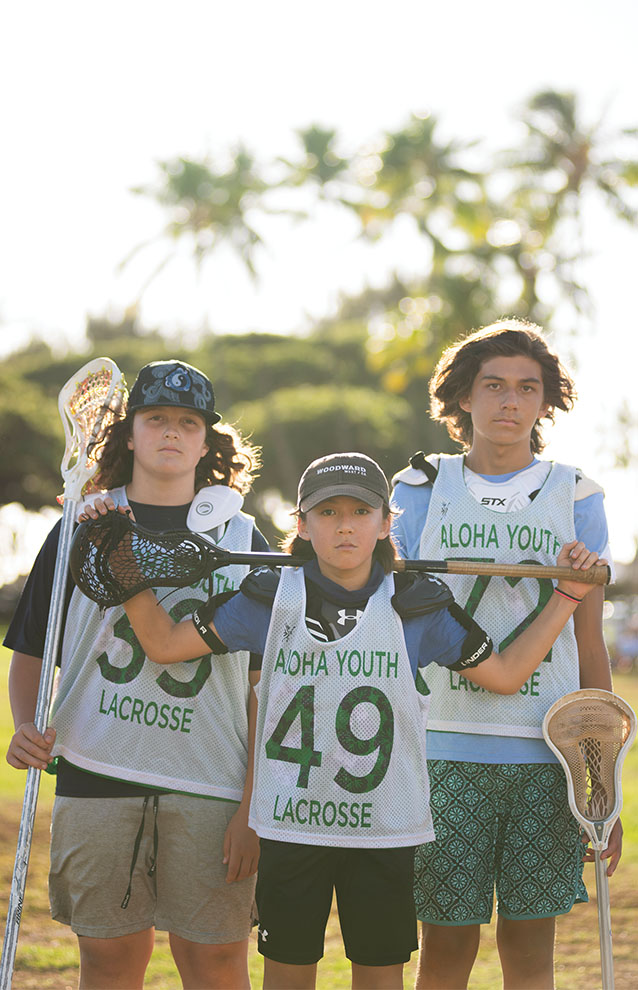 Matt Sauri is coming to Hawaii for two reasons: to get married and play lacrosse. But not in that order. Lacrosse first, then the wedding. It's his second marriage and his twenty-third time playing in Hawaii's lacrosse tournament, which is kind of like the destination wedding of lacrosse. Japan, South Korea, Israel, the Czech Republic, Germany and Canada have all sent teams. In 2012 the Haudenosaunee Nationals, formerly known as the Iroquois Nationals, were headed to the World Lacrosse Championships in England but were denied entry because the UK would not recognize their Haudenosaunee passports-so they came to Hawaii instead and swept the games.
Matt Sauri is coming to Hawaii for two reasons: to get married and play lacrosse. But not in that order. Lacrosse first, then the wedding. It's his second marriage and his twenty-third time playing in Hawaii's lacrosse tournament, which is kind of like the destination wedding of lacrosse. Japan, South Korea, Israel, the Czech Republic, Germany and Canada have all sent teams. In 2012 the Haudenosaunee Nationals, formerly known as the Iroquois Nationals, were headed to the World Lacrosse Championships in England but were denied entry because the UK would not recognize their Haudenosaunee passports-so they came to Hawaii instead and swept the games.
In 2022 the thirtieth annual tournament-delayed two years because of the pandemic-is being held in Kapiolani Park, with Diamond Head as the backdrop. "Thirty years," reflects Jay Bloom, one of the founders of the Hawaii Lacrosse Club, who's watching with a mix of pride, wonder and nostalgia. "This is what comes from a bunch of guys throwing a ball around in the park. And now some of the best lacrosse talent in the world is right here."
Although lacrosse is often associated with East Coast prep schools, Native Americans invented the sport. The Creek called it the "younger brother of war," and the Cherokee, "little war"-they would often use the game to settle disputes. But lacrosse also has spiritual roots as a "medicine game" to bring about good weather or heal people and communities. Entire villages would play games that could stretch out for days.
In the mid-nineteenth century, Montreal dentist George Beers adapted the game, codifying what would become modern-day lacrosse. (The name likely comes from the French, who called any game played using a curved stick "lacrosse.") Beers wanted lacrosse to become Canada's national sport, which it did in 1859, and it remains so along with ice hockey (lacrosse being the national summer sport and hockey the winter). Lacrosse was a precursor to ice hockey and basketball as well-the inventor of basketball was a lacrosse player-and the rules of ice hockey were modeled on those of lacrosse. Writer John McPhee called it "football, basketball and ice hockey in an advanced stage of evolution."
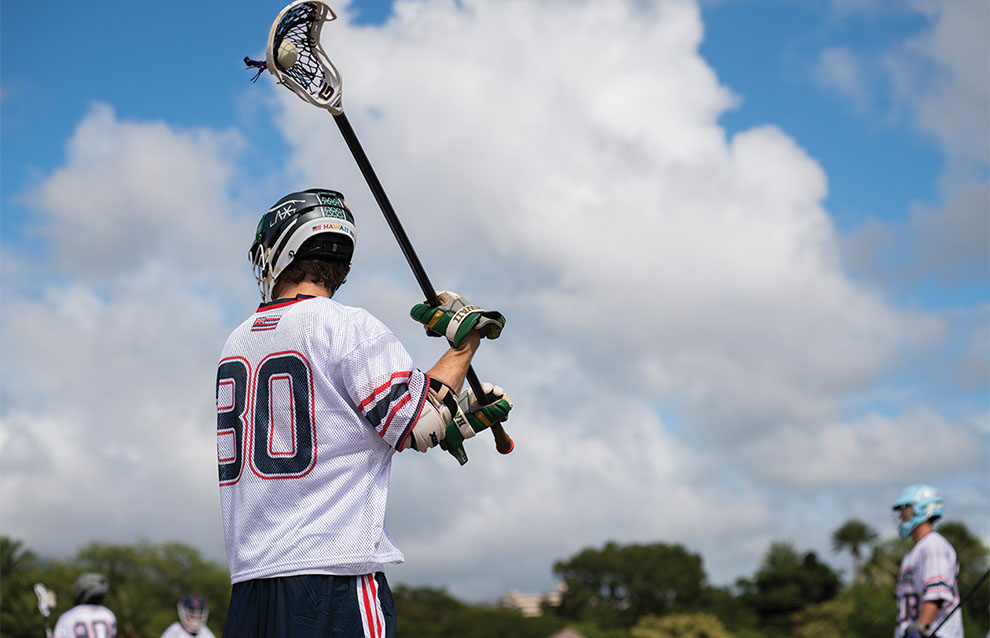
Many of the lacrosse players in Hawaii’s adult league coach kids in the Aloha Youth Lacrosse Association (AYLA), and pros who come to play in the league’s annual tournament in Honolulu (seen on the previous page) host a clinic for the youth. Since its founding in 2003, AYLA has grown to more than 450 members. One of the coaches, Sarah Medwell Redican, says that because the sport is relatively new to Hawaii, “Kids can come in late to the game, and there’s gonna be a lot of other people on the team starting at the same level.”
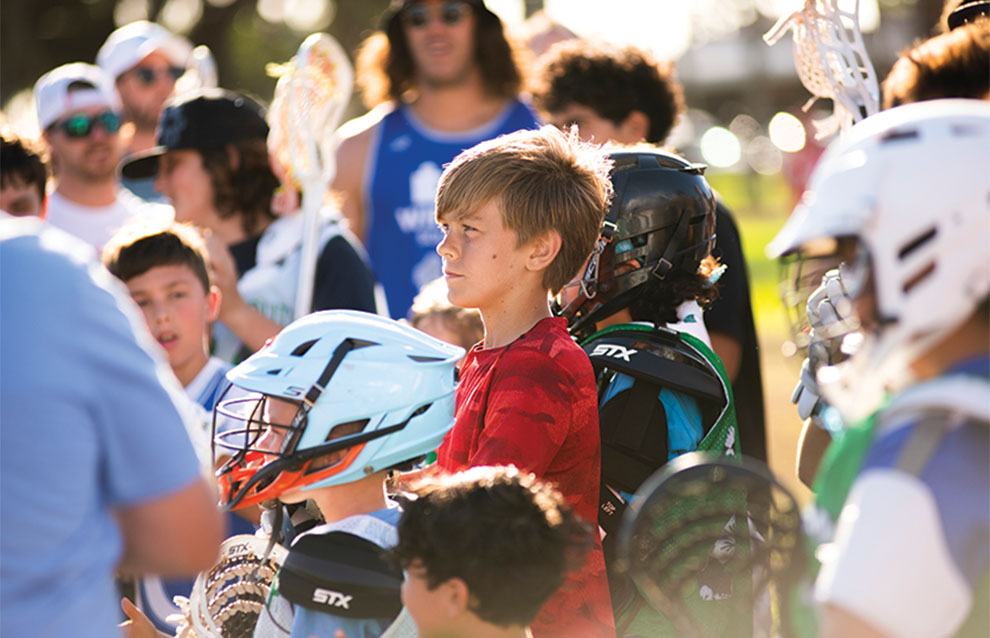
Yet compared with those other sports it's obscure, which might explain why it's now one of the fastest-growing sports in the world: There is only one direction to go. It has spread from its New England epicenter westward, to Colorado, California, Hawaii, Japan. And every last weekend of October, in some ways conjuring lacrosse's origins, far-flung teams gather in Honolulu for three days of games and three nights of parties, rejoining alumni of college lacrosse teams, uniting on one team pro players who usually play against each other, and bonding Hawaii's lacrosse community, some hundred men and fifty women. There are a lot of beers and bruises.
Bloom played lacrosse in high school and college in Upstate New York, "the logical sport to play in the hotbed of lacrosse" in the 1970s and '80s, he says. When he came to Hawaii in 1989, he and a few others-not even enough to field a single lacrosse team of ten players-began tossing a ball around at Kapiolani Park. Their ball and sticks became a homing beacon for others who enjoyed this rare sport. Driving around the park one day, Kent Ames, who had played lacrosse at Chapman University for a year before he returned home, saw them and introduced himself. One by one the community grew: "One day, we had eight people, four on four and no goalie, and out of the parking lot comes our first goalie," Ames recalls. "Out of nowhere he just jumps into the goal, starts screaming, 'Ball top left!' We got a goalie! We're legit!"
Another day, a Canadian tourist who also happened to play suggested they get a team together and play in an upcoming tournament in Portland, Oregon. When they arrived "there was so much curiosity that there was lacrosse in Hawaii," Bloom says. "They said, 'If you ever have a tournament in Hawaii ...' It's like in that baseball movie Field of Dreams: If you build it, they will come." In 1991 the Hawaii Lacrosse Club held its first tournament with four teams: Mount Washington Tavern from Baltimore, arguably the best men's club team in the country at the time; the Moon Doggies from San Diego; the Haole Lacrosse Club from Canada (so named when they play in the Hawaii tourney); and the home team. In 2022, uncertainty in pandemic travel restrictions has constricted the tournament to eighteen men's and eight women's teams, the smallest it's been in recent memory; before the pandemic, forty teams would convene, with five or six from Japan, a rising star in lacrosse.
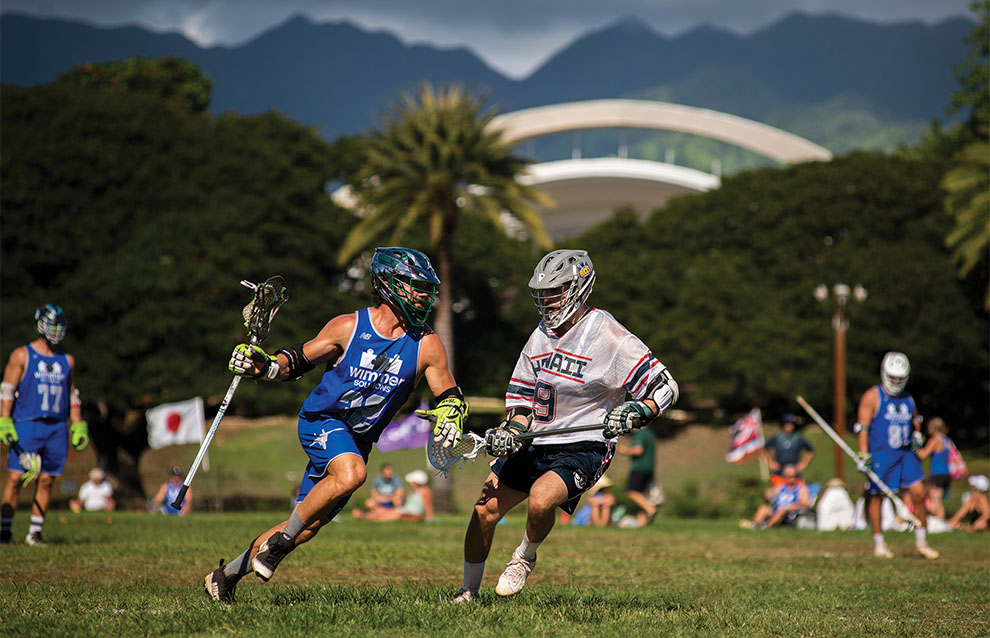
A player on the Wimmer Solutions team (in blue jersey) makes an offensive play. Wimmer Solutions is an all-pro team; of the seventeen times they’ve participated in the Hawaii tournament, they’ve won almost all of their games (one of their rare defeats was when the Iroquois Nationals made an appearance in 2012). In this match, Wimmer soundly defeated Hawaii’s men’s team. “It’s like playing the Lakers,” Hawaii’s goalie says.
Today the HiLax Ohana, as its members call it, ranges in age from 18 to 69. Lacrosse is one of the rare contact sports one can play competitively when you get into the senior discount age, or "basically, until you drop dead," says Ames, who is 52. Although, they have to pull back a little in the 50-and-over division. "The first two minutes in the game, I'm playing defense and a guy's coming down with the fast break," says Steve Chamberlain, 53, during his first time playing in this division at the tournament. "I slide and I take the shit out of him. I'm doing my job. The ref pulls me over and is like, 'Hey man you can't do that. Now that you're in the over-50s, you can't do this whole takeout check thing.' One of the players on the other team is 70 years old.
Even when they're checking each other into the turf, "the HiLax Ohana is all my best friends," Ames says. "It's a real tight group-maybe because we're out in the middle of the Pacific, we just have this bond. Once you're in, you're in. And unlike places on the Mainland, we're all ages. We get together every Sunday, we break into teams, we split up the old guys, split up the young guys." One player calls lacrosse his church. On Sunday afternoons at Kapiolani Park from February to October, they play, then pull out the coolers and chairs and stay long after dark.
I fall for the hidden ball trick. During one of the tournament games, an offensive player feints passing to another, who takes off running toward the goal. He shoots toward the net while the goalie lunges ... at nothing. There's no ball. Meanwhile, the other player, who never did pass it, whips the ball into the now open space in the net. As an uninitiated observer, I don't even know what happened-someone has to explain it to me later.
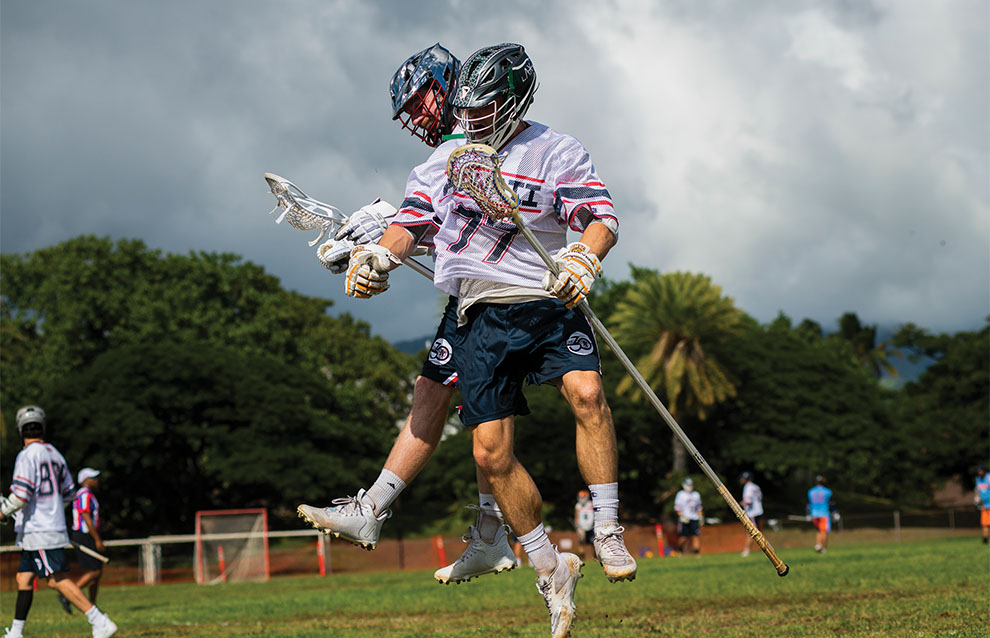
A player on the Wimmer Solutions team (in blue jersey) makes an offensive play. Wimmer Solutions is an all-pro team; of the seventeen times they’ve participated in the Hawaii tournament, they’ve won almost all of their games (one of their rare defeats was when the Iroquois Nationals made an appearance in 2012). In this match, Wimmer soundly defeated Hawaii’s men’s team. “It’s like playing the Lakers,” Hawaii’s goalie says.
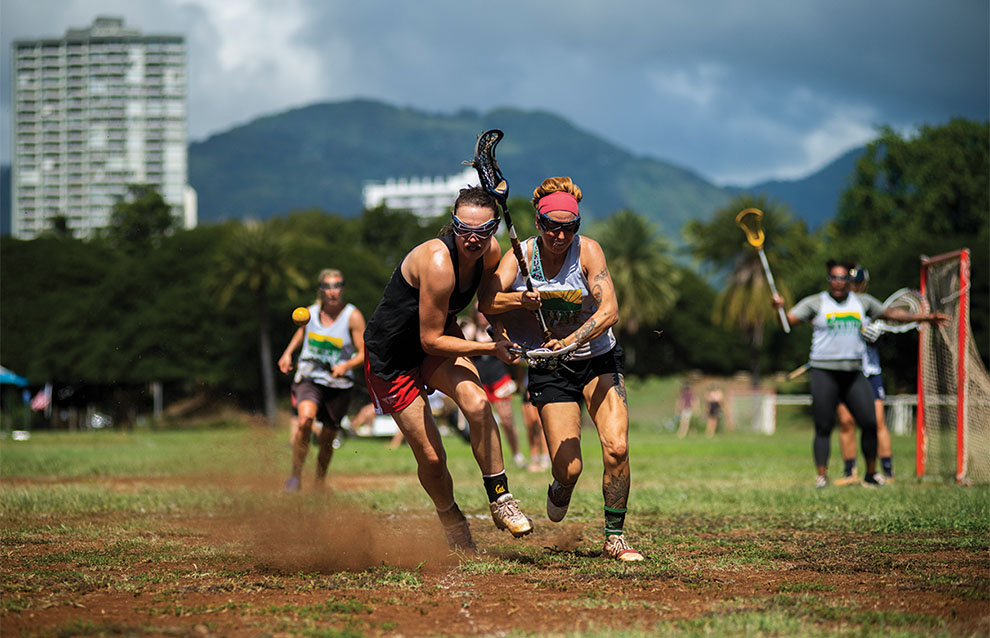
Lacrosse is fast, with little downtime. The eight-inch ball is constantly moving, and I'm always losing sight of it as it hurtles back and forth across a field about the same area as a soccer pitch. Lacrosse is often referred to as the fastest game on two feet, and the ball, shot from a basket at the end of a long-handled stick, can fly at a hundred miles an hour. The players are heavily armored in helmets, gloves, shoulder and arm pads, mouthguards and sometimes cups. Even so, by the end of the weekend, a ball broke a goalie's hand and ruptured another player's eardrum. I'd heard about the violence of the game, but seeing it in person for the first time, I'm unprepared: the men whaling on each other with their stiff metal sticks, aiming at hands, arms and shoulders in an effort to dislodge the ball. It seems more violent than football, being able to use more than your body to attack. And yet that same stick, sometimes wielded as a club, is also an elegant extension of a player's arm, adroitly plucking a speeding ball from the air, cradling and protecting it the way one might net a butterfly.
Women's lacrosse is technically a noncontact sport, but the bruises on their arms say otherwise. Outfitted in lighter battle gear- mouthguards and goggles that resemble cages-the women defend less through checking than by putting their sticks where offensive players need to be. The price of the women's championship game, in which the Hawai'i women beat the Olympic Club from San Francisco by one goal in the last minute of the game, is a concussion from a hard fall and an overworked ACL that will require a lot of ice.
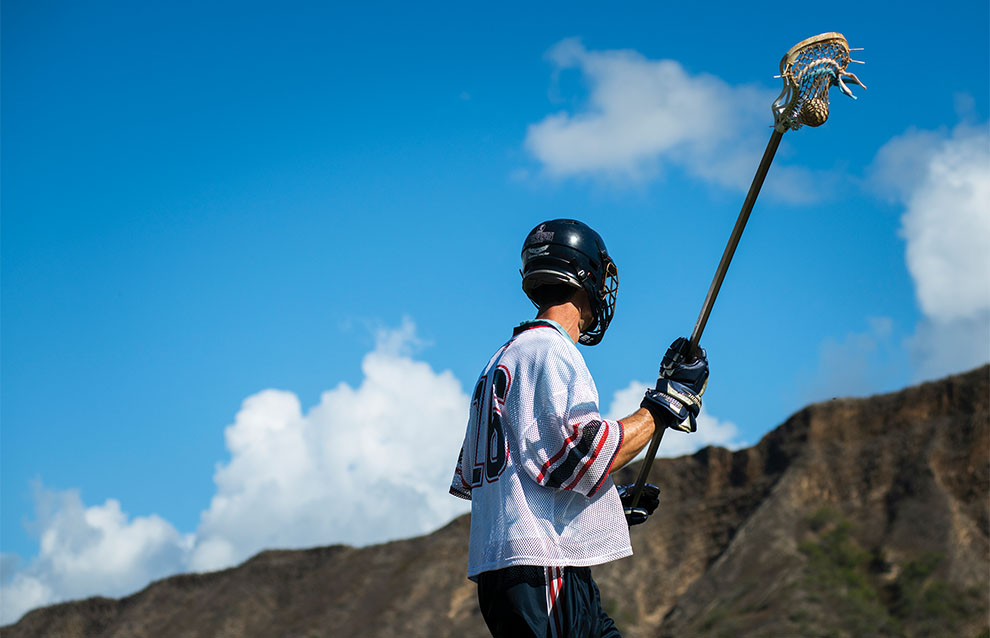
The Hawaii Lacrosse Club began in 1989, when a couple of guys started throwing around a ball in Kapiolani Park. They eventually gathered enough players to form a team, hosted Hawaii’s first tournament in 1991 and won a tournament in Lake Tahoe, “taking everyone by surprise,” says Hawaii player Kent Ames. Now, about one hundred men and fifty women play in the club, and the annual tournament is legendary for the games and the after-parties.
"Lacrosse creates an incredible sense of community," Sarah Medwell Redican agrees. "Wherever you land around the world, you'll likely meet someone who's played with or against, has coached or been coached by someone you know. Although it's a massively growing sport, it still feels like such a tight community." Medwell Redican played in middle and high school in Seattle, just as the game was gaining a foothold there, then attended the University of Denver on a lacrosse scholarship. When she moved to Hawaii, she immediately joined the Hawaii Lacrosse Club and began coaching with the Aloha Youth Lacrosse Association. Prior to the pandemic, it comprised four hundred-some youth, from kindergartners to high school seniors. While a few Island schools have club teams, AYLA's goal is to raise lacrosse to a varsity sport in Hawaii high schools. So far, Saint Louis School and Punahou School have signed on to be trial schools, and Ames hopes that Kamehameha Schools will also join, especially given the sport's indigenous roots.
"It's like playing the Lakers," says goalie Jason Dow, coming off the field of the masters finals in which Wimmer Solutions dominated Hawaii Lacrosse Club 10 to 3. Wimmer Solutions is Sauri's team, named after the Seattle-based company that he founded. He stacks the teams with all-star pros, and they have won twelve of the seventeen times they've attended the Hawaii tournament. This year the team includes seventeen professionals, and this tournament is one of the few times they all get to play with one another on the same team. Their win is practically a foregone conclusion.
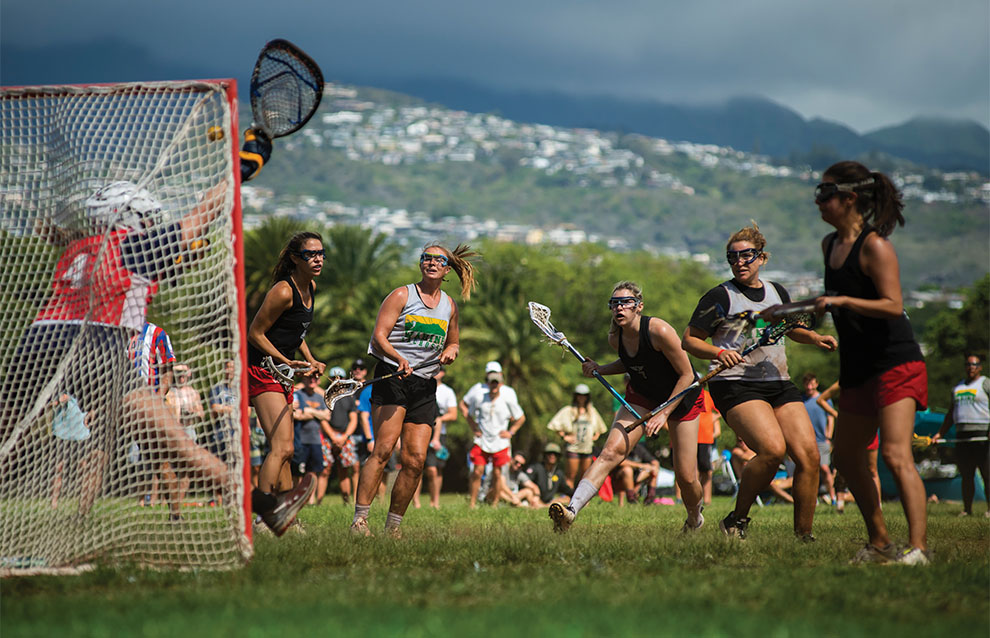
Wahine Hawaii (seen above in gray jerseys) plays the Olympic Club from San Francisco in the women’s championship game. They traded goals for a tied game until the last minute, when Hawaii won with a penalty shot with two seconds left. Women’s lacrosse is technically a non-contact sport, but the bruises on their arms prove otherwise.
Even if the victory is concentrated, the reward is shared-Wimmers donates their winnings to charities helping youth struggling with addiction and survivors of domestic abuse. Beyond the social benefit, "one of my goals is to help grow the game here in Hawaii," Sauri says. On the tournament's last day, Wimmers' players run a clinic for youth-some so small that they look like bobbleheads with their helmets on-and donate lacrosse equipment, which can be a barrier to entry. "If you think you're here just because you're a great lacrosse player, you're mistaken," Sauri tells his players. "You're here because we believe that you have something to offer the world and your community."
More than thirty years ago, Ames almost didn't play lacrosse. He'd joined a fraternity whose members comprised almost the entire nascent lacrosse club at Chapman University. They invited him to play, but he didn't have money for gear. One day, his counselor-who happened to be a lacrosse enthusiast-was teaching him to use WordPerfect on one of the first Macs at the school. When Ames mentioned his dilemma, the counselor immediately switched off the computer, took Ames to a sporting goods store and bought him everything he needed. "It was the best gift I ever got in my life," he says.


